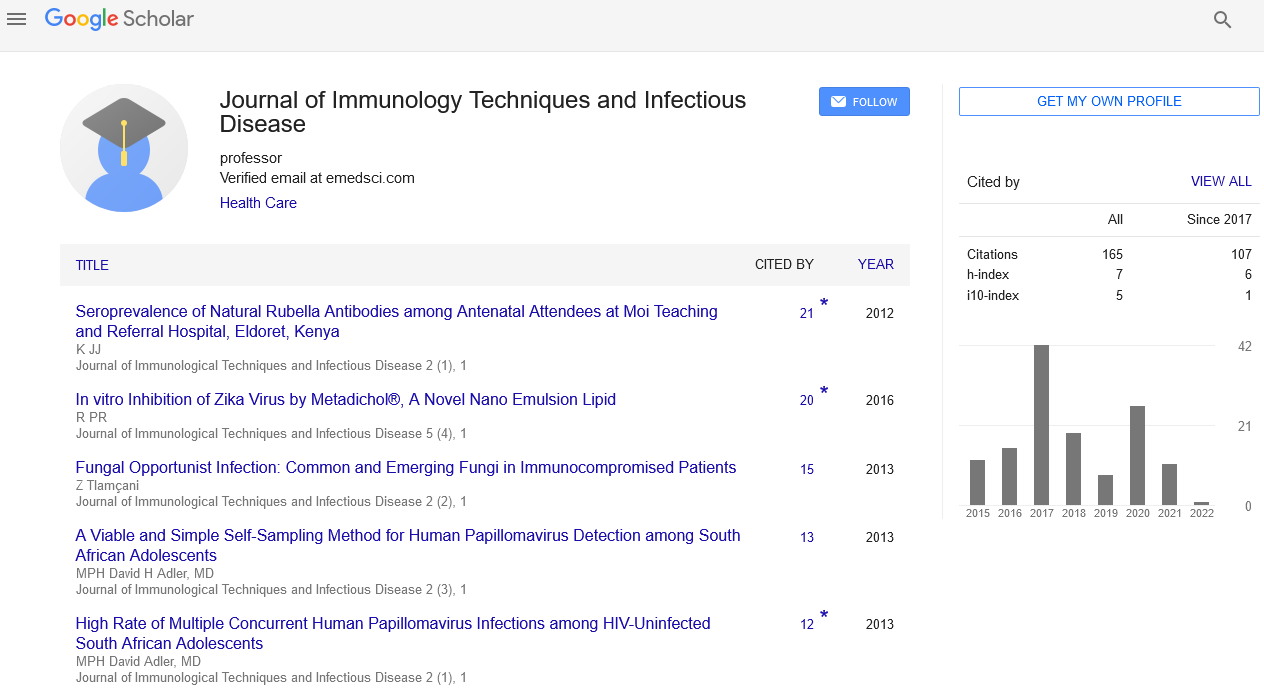Opinion Article, J Immunol Tech Infect Dis Vol: 12 Issue: 2
An Overview on Complement Fixation Test
Masiba Auri*
1Department of Clinical Veterinary Studies, University of Zimbabwe, Harare, Zimbabwe
*Corresponding Author: Masiba Auri,
Department of Clinical Veterinary Studies,
University of Zimbabwe, Harare, Zimbabwe
E-mail: masibaauri1@gmail.com
Received date: 29 May, 2023, Manuscript No. JIDIT-23-105437;
Editor assigned date: 31 May, 2023, PreQC No. JIDIT-23-105437 (PQ);
Reviewed date: 14 June, 2023, QC No. JIDIT-23-105437;
Revised date: 21 June, 2023, Manuscript No. JIDIT-23-105437 (R);
Published date: 28 June, 2023, DOI: 10.4172/2329-9541.1000345.
Citation: Auri M (2023) An Overview on Complement fixation Test. J Immunol Tech Infect Dis 12:2.
Description
In the realm of immunology, accurate and reliable diagnostic tests are essential for identifying and monitoring various diseases. One such test, known as the Complement Fixation Test (CFT), has played an important role in diagnosing and studying infectious and immunemediated disorders for decades. The CFT is a valuable tool that enables scientists and healthcare professionals to detect and measure the presence of specific antibodies in patient samples. In this will explore into the principles, procedure, and applications of the complement fixation test, highlighting its significance in medical research and clinical practice.
The complement fixation test operates on the principles of antigenantibody interactions and the subsequent activation of the complement system, an essential component of the immune response. The test is primarily based on the ability of antibodies to fix or bind complement proteins, leading to the activation of the complement cascade.
The complement cascade involves a series of enzymatic reactions, ultimately resulting in the lysis of target cells or particles. When antibodies bind to antigens present in the patient's sample, they form immune complexes. In the CFT, the patient's serum is mixed with a known amount of the specific antigen and complement proteins. If the patient's serum contains antibodies against the antigen, they will bind to it, preventing the complement from being fixed. Consequently, there will be no activation of the complement system.
To determine the presence of complement fixation, a standardized amount of Red Blood Cells (RBCs) sensitized with antibodies to the complement component (usually sheep RBCs) is added to the mixture. If the complement is fixed due to the absence of antibodies in the patient's serum, the added sensitized RBCs will not be lysed. However, if the antibodies are present in the patient's serum and have fixed the complement, the sensitized RBCs will undergo lysis, leading to a decrease in the turbidity of the solution.
Procedure of the complement fixation test
The complement fixation test involves a series of meticulous steps to ensure accurate and reproducible results. The following is a generalized outline of the CFT procedure.
Preparation of reagents: The required reagents include antigens, complement proteins, and sensitized red blood cells. Antigens can be obtained from various sources, such as microorganisms or purified proteins. Complement proteins can be sourced from fresh human or animal serum. Sheep RBCs are typically used for sensitization.
Serum dilution: The patient's serum is diluted to a standardized concentration, typically using buffered saline solution or veronalbuffered saline.
Complement fixation stage: In this step, the diluted patient's serum is mixed with a known quantity of the specific antigen and complement proteins. If antibodies against the antigen are present, they will bind to the antigen, preventing complement fixation.
Sensitized RBC addition: Standardized amounts of sensitized RBCs are added to the mixture from the previous step. If complement fixation has occurred, the sensitized RBCs will not undergo lysis due to the absence of active complement proteins.
Incubation: The test tubes or microplates containing the mixture are incubated at an appropriate temperature for a specified duration, allowing for immune complex formation and possible complement fixation.
Indicator System: After incubation, an indicator system is added, which typically consists of complement components and RBCs that are not sensitized. If the complement fixation has occurred, the indicator system will lead to lysis of the RBCs, resulting in a decrease in turbidity.
Interpretation: The test tubes or microplates are observed for any changes in turbidity, indicating whether complement fixation has taken place or not. A positive result is indicated by a decrease in turbidity, whereas no change in turbidity signifies a negative result.
 Spanish
Spanish  Chinese
Chinese  Russian
Russian  German
German  French
French  Japanese
Japanese  Portuguese
Portuguese  Hindi
Hindi 
